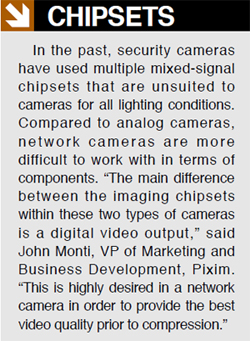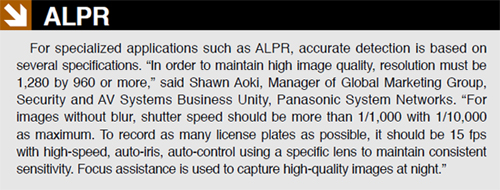While security cameras have evolved continuously, few can perform up to par after the sun sets. Thus, what determines the effectiveness of a camera is how well it performs during the vulnerable hours of darkness, when criminal activity is most likely to occur. A&S looks at how far low-light cameras have come along and how they break new ground.
While security cameras have evolved continuously, few can perform up to par after the sun sets. Thus, what determines the effectiveness of a camera is how well it performs during the vulnerable hours of darkness, when criminal activity is most likely to occur. a&s looks at how far low-light cameras have come along and how they break new ground.
In detecting what is invisible to the naked eye, R&D efforts have made leaps and bounds in active IR technology — the use of invisible IR light to illuminate a scene or subject and capture it, using an analog or network camera. Advances in thermal cameras — drawing pictures from heat energy regardless of visible light or additional illumination — have also been noticeable. Other image enhancement technologies include improved image sensors and WDR capabilities, as well as shutter/noise reduction (SNR) mechanisms and high-resolution chipsets.
Unlike thermal IR that detects without light, active IR cameras require additional light. They work with IR filters to obtain usable footage. However, the biggest drawback for active IR is balancing camera sensitivity against the additional light used.
The performance of IR LEDs depends on whether they are inside or outside the camera housing. “Outside of the camera housing basically means using a separate illuminator,” said Ad Biemans, EMEA Product Marketing Manager for CCTV, Bosch Security Systems.
Aside from efficiency — more optical power for the same electrical power — the benefits of using IR outside the housing is better thermal management and cooling due to a larger dedicated heat sink. Furthermore, the separation of the camera and illuminator allows for better video analytics. “Active IR cameras attract insects and spiders which can trigger alarms,” Biemans said. “Separating the camera and illuminator by at least 30 centimeters significantly reduces this.”
 SNR Mechanisms
SNR Mechanisms
Global electronic shutter enables the imaging of fast-moving objects without motion blur or distortion, which is critical for security applications. “Image sensors with interlace shutter or rolling shutter exhibit poor performance in scenes with motion,” said John Monti, VP of Marketing and Business Development, Pixim. “An effective global electronic shutter is one that reduces motion artifacts caused by the sensor.”
Motion blur is a challenge for outdoor monitoring applications, such as parking lots. For areas with little motion, cameras can now analyze multiple frames and remove noise at once to get clearer picture, said Yoshikazu Hirano, GM for Security Solutions, Business and Professional Products of APAC, Sony Electronics. “With more motion, noise reduction is managed in the moving part of the image. Electric gain can be increased instead of using slow shutter, and as a result, better clarity can be obtained without much blur.“
 Image Sensors
Image Sensors
Network cameras provide improved quality and resolution over traditional analog cameras. However, more analog cameras are available for a wider variety of applications, compared to network cameras. Coping with operating light levels is the biggest challenge for network cameras in terms of sensitivity, said Shawn Aoki, Manager of Global Marketing Group, Security and AV Systems Business Unit, Panasonic System Networks. Sensitivity needs to be improved to near-IR levels in order for resulting images to appear less grainy. “This can be overcome by a unique CMOS sensor which improves low-light capability,” he said.
For the most part, network and analog cameras use the same sensors. “But SNR'ed video has the added benefit of generating a lower bit rate compared to an unilluminated nighttime scene,” Biemans said.
With adoption of on-chip microlens technology, sensitivity of the latest CMOS sensor is nearly the same as that of a CCD, Hirano said. “Because of the high-speed processing capability, CMOS sensors can now deliver quality images even in low-light conditions. Lux ratings are just levels of peak white, which don't explain gradation and visibility.”
Enhancing Visibility
 Enhancing visibility in areas shy of light can be tough to tackle. However, modern postcapture technology has eased this problem. “It captures and dynamically monitors signal levels, reducing the extreme levels of brightness within the scene and increases level within the darker areas by remapping — pixel by pixel, frame by frame,” Hirano said. “This simultaneous processing and adjustment of both light and dark areas of the scene delivers improved WDR performance with enhanced scene visibility.”
Enhancing visibility in areas shy of light can be tough to tackle. However, modern postcapture technology has eased this problem. “It captures and dynamically monitors signal levels, reducing the extreme levels of brightness within the scene and increases level within the darker areas by remapping — pixel by pixel, frame by frame,” Hirano said. “This simultaneous processing and adjustment of both light and dark areas of the scene delivers improved WDR performance with enhanced scene visibility.”
New solutions can provide a nearly fourfold increase in sensitivity at normal shutter speeds, Hirano said. This patented technology is effective for monitoring moving objects, combining image data from multiple horizontally and vertically aligned pixels to produce extremely bright images. “This function can be activated automatically in response to surrounding light conditions or on a prespecified time schedule,” he said.
Cost Considerations
Different prices for active IR cameras result in performance differences. “Low-end active IR cameras use cheap LEDs plated through holes, which do not have the best thermal management,” Biemans said. “This leads to low efficiency and reduced component life time and hence , produc t lifetime.”
Optimal LED placement is surfacemounted or directly cast on the circuit board. “High-end cameras also manage the geometrical profile of the illumination,” Biemans said. “It's no use outputting a circular field of illumination, as you end up with overexposed foreground, low illumination in the background and much light wasted in the air.”
 Suggestions
Suggestions
Purchasing an effective active IR camera varies, depending on the application. For example, a shortrange retail store would require a different active IR camera compared to a critical infrastructure site. “For low-end projects, most cameras are roughly equal,” Biemans said. “Make sure the varifocal lens provides necessary flexibility, and the LED divergence angle provides the necessary coverage.”
More demanding applications require greater fine-tuning. “For high-end projects, integrated IP coding, adjustable IR intensity and adjustable vertical angles of LED panels should be looked into to allow for adjustment of foreground and background illumination,” Biemans said. “To combat any leftover saturation or dark spots, use a WDR camera.”
Choosing a security camera for optimum low-light performance should be based on several considerations. The lux or minimum illumination rating should not be the only factor, as lux ratings from different manufacturers measured by different criteria are subjective. “Lux rating is useful when comparing products from the same manufacturer, but using it to compare across different manufacturers is virtually useless,” Hirano said.

 Solid components should be factored in, as they enhance low-light performance. For instance, the DSP has a marked effect on the quality and performance of the video image produced by the camera. “While black-and-white cameras have the ability to capture better image quality in low-light conditions, color adds critical surveillance details, such as identifying the color of clothing for a crime suspect or a getaway car,” Hirano said.
Solid components should be factored in, as they enhance low-light performance. For instance, the DSP has a marked effect on the quality and performance of the video image produced by the camera. “While black-and-white cameras have the ability to capture better image quality in low-light conditions, color adds critical surveillance details, such as identifying the color of clothing for a crime suspect or a getaway car,” Hirano said.
Up Ahead
The future of low-light cameras includes improvement of the low-light capabilities of CMOS sensors, as well as improving the distance and amount of light while lowering power consumption, Aoki said.
Furthermore, increasing the speed of CMOS sensors is important. “The future goal is to combine higher speeds with higher resolutions in pixel size while compensating for reductions in sensitivity resulting from reductions in pixel size (due to more pixel counts),” Hirano said. “This will be achieved using device process technology, circuit technology and image-processing technology.”